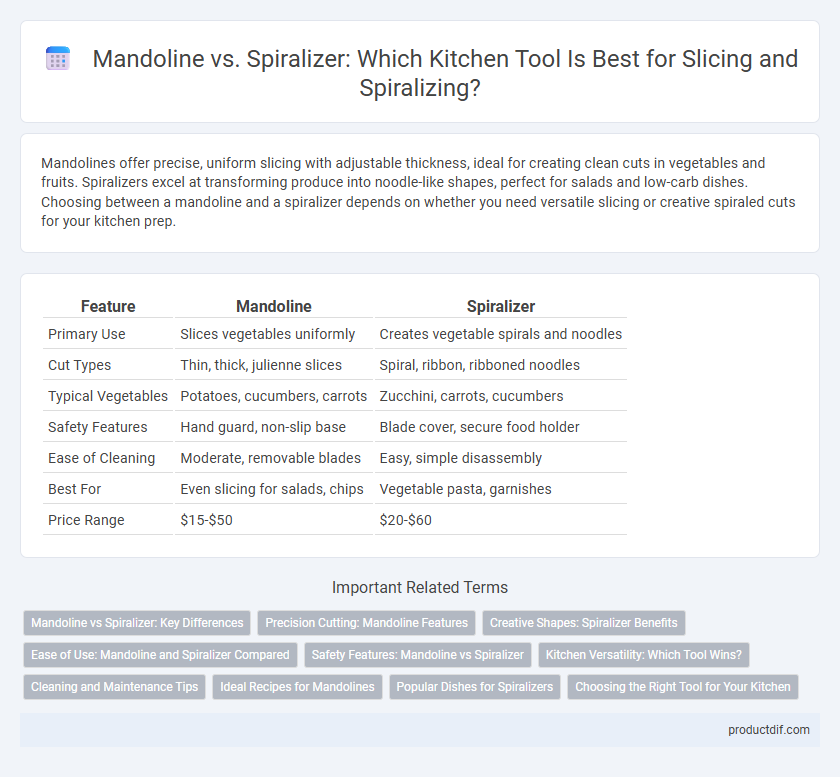Mandolines offer precise, uniform slicing with adjustable thickness, ideal for creating clean cuts in vegetables and fruits. Spiralizers excel at transforming produce into noodle-like shapes, perfect for salads and low-carb dishes. Choosing between a mandoline and a spiralizer depends on whether you need versatile slicing or creative spiraled cuts for your kitchen prep.
Table of Comparison
| Feature | Mandoline | Spiralizer |
|---|---|---|
| Primary Use | Slices vegetables uniformly | Creates vegetable spirals and noodles |
| Cut Types | Thin, thick, julienne slices | Spiral, ribbon, ribboned noodles |
| Typical Vegetables | Potatoes, cucumbers, carrots | Zucchini, carrots, cucumbers |
| Safety Features | Hand guard, non-slip base | Blade cover, secure food holder |
| Ease of Cleaning | Moderate, removable blades | Easy, simple disassembly |
| Best For | Even slicing for salads, chips | Vegetable pasta, garnishes |
| Price Range | $15-$50 | $20-$60 |
Mandoline vs Spiralizer: Key Differences
Mandolines feature a flat surface with adjustable blades for precise, uniform slicing and julienne cuts, ideal for vegetables like potatoes and cucumbers. Spiralizers create continuous, noodle-like spirals from vegetables such as zucchini or carrots, perfect for low-carb pasta alternatives. Mandolines excel in versatility and thickness control, while spiralizers are specialized for creating vegetable spirals.
Precision Cutting: Mandoline Features
Mandolines offer exceptional precision cutting with adjustable blades that create uniform slices, julienne, and waffle cuts. Their sharp, straight-edged blade ensures consistent thickness, enhancing presentation and even cooking. This precision surpasses many spiralizers, which are typically limited to producing spiral-shaped cuts.
Creative Shapes: Spiralizer Benefits
Spiralizers excel in creating creative shapes by transforming vegetables into long, curly spirals and ribbons, enhancing presentation and texture in dishes. Unlike mandolines, which primarily produce uniform slices and julienne cuts, spiralizers offer versatility in creating noodles, ribbons, and intricate spirals ideal for low-carb and vegan recipes. Their ability to produce visually appealing, healthy alternatives to traditional pasta makes spiralizers a popular kitchen tool for creative culinary expression.
Ease of Use: Mandoline and Spiralizer Compared
Mandolines offer precise, adjustable slicing with minimal effort but require careful handling to avoid injury, making them suitable for experienced users. Spiralizers excel in effortlessly creating uniform vegetable spirals, especially for softer produce, and often come with safety features for beginners. Choosing between them depends on the desired cut style and user's comfort with kitchen tools.
Safety Features: Mandoline vs Spiralizer
Mandolines feature adjustable blades with hand guards and non-slip bases to reduce the risk of cuts during slicing, while spiralizers use enclosed cutting mechanisms that keep fingers away from sharp blades. Spiralizers often have safety locks and sturdy construction, minimizing accidental blade exposure, making them safer for continuous use. Both tools require careful handling, but spiralizers generally provide enhanced protection through their enclosed design compared to the more exposed blades of mandolines.
Kitchen Versatility: Which Tool Wins?
A mandoline offers precise, uniform slicing and julienne cuts, ideal for tasks requiring consistent thickness, while a spiralizer excels at transforming vegetables into noodles or ribbons, perfect for creative, healthy meals. Mandolines handle a wide range of slicing tasks including crinkle cuts and waffle patterns, enhancing meal presentation and prep speed. Spiralizers, however, specialize in vegetable transformation, making them indispensable for spiralized salads, gluten-free pasta alternatives, and decorative garnishes in diverse culinary applications.
Cleaning and Maintenance Tips
Mandolines feature flat blades and removable parts that require careful hand washing to prevent rust and maintain sharpness, with most components needing immediate drying to avoid water damage. Spiralizers generally consist of fewer parts and often dishwasher-safe materials, making cleaning quicker and less labor-intensive but still demanding blade caution to preserve cutting performance. Consistent maintenance, including blade sharpening for mandolines and thorough rinsing of spiralizer blades, ensures longevity and optimal kitchenware function.
Ideal Recipes for Mandolines
Mandolines are perfect for creating uniformly thin slices ideal for dishes like gratins, potato chips, and ratatouille. Their adjustable blades allow precise thickness control, making them suitable for slicing firm vegetables such as cucumbers, carrots, and zucchini. This precision enhances recipes requiring consistent texture and presentation, such as layered vegetable casseroles and fresh salads.
Popular Dishes for Spiralizers
Spiralizers are popular for creating visually appealing and healthy dishes like zucchini noodles, sweet potato spirals, and curly vegetable salads. They excel in preparing low-carb alternatives to pasta and enhancing stir-fries with vibrant, uniform spirals. Chefs and home cooks favor spiralizers for recipes that emphasize fresh, crisp textures and artistic presentation.
Choosing the Right Tool for Your Kitchen
Selecting the right kitchen tool depends on your meal preparation needs: a mandoline excels in creating consistent, thin slices of vegetables and fruits, ideal for salads and chips, while a spiralizer is perfect for turning vegetables into noodles or ribbons, enhancing low-carb and creative dishes. Consider storage space and ease of cleaning; mandolines are typically compact but require caution due to sharp blades, whereas spiralizers vary in size and may have multiple attachments for different spiral shapes. Prioritize functionality, safety features, and the types of recipes you frequently cook to make the best choice for your kitchen.
Mandoline vs spiralizer Infographic

 productdif.com
productdif.com